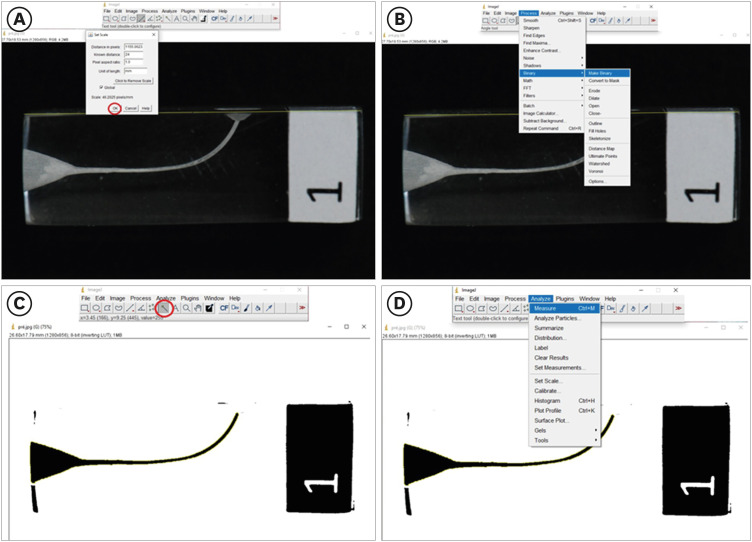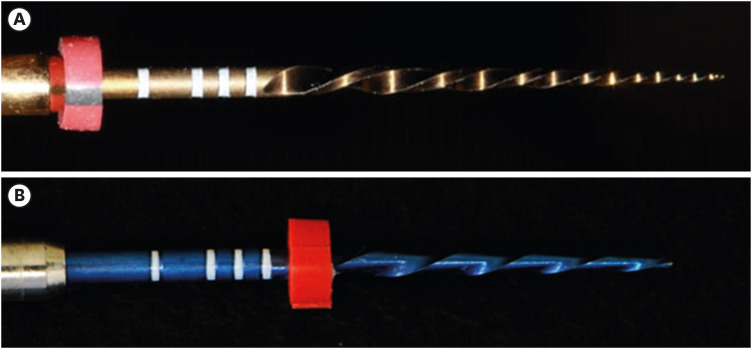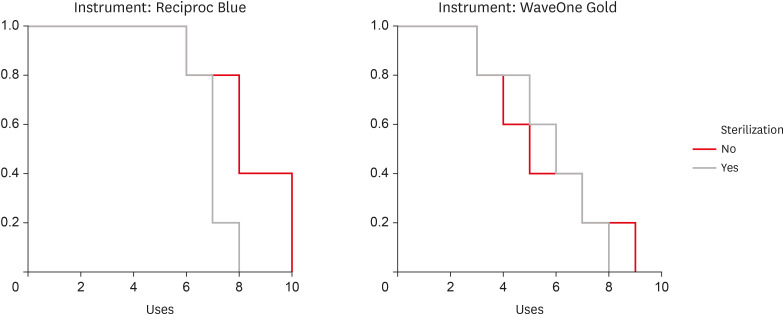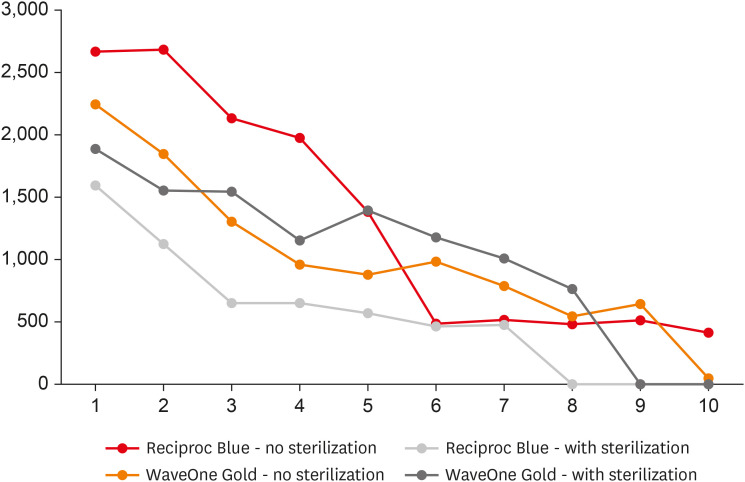Restor Dent Endod.
2021 May;46(2):e28. 10.5395/rde.2021.46.e28.
Effect of number of uses and sterilization on the instrumented area and resistance of reciprocating instruments
- Affiliations
-
- 1Graduation Program in Dentistry, Federal University of Pelotas, Pelotas, RS, Brazil
- 2Department of Endodontics, Universidade de Fortaleza, CE, Brazil
- 3Department of Endodontics, Federal University of Maranhão, São Luiz, MA, Brazil
- KMID: 2548072
- DOI: http://doi.org/10.5395/rde.2021.46.e28
Abstract
Objectives
This study evaluated the effect of repeated uses and autoclaving in the instrumented area, fracture resistance, and time of instrumentation of thermally treated nickel-titanium reciprocating systems.
Materials and Methods
Two hundred simulated canals were instrumented using Reciproc Blue and WaveOne Gold. Each file was used up to 10 times or until fracture. The instrumented area was measured in pre- and post-operative images, using ImageJ software. Kaplan-Meier survival analysis evaluated the number of uses of instruments before fracture. Instrumented area and time of instrumentation were analyzed by Mann-Whitney U test and Kruskal-Wallis. Correlations among the number of uses and instrumented area were measured. The level of statistical significance was set at p < 0.05.
Results
Reciproc Blue presented a higher estimated number of uses in comparison with WaveOne Gold (p = 0.026), but autoclaving did not affect the resistance to fracture of instruments (p > 0.05). The instrumented area was different among the evaluated groups (p = 0.039), and the instrumented area along the uses of both tested instruments was reduced. With the time of instrumentation, there was also a significant difference among the evaluated groups; the groups without sterilization cycles were faster, in comparison to those submitted to autoclaving (p = 0.010).
Conclusions
Reciproc Blue was more resistant than WaveOne Gold, suffering later fracture. Additionally, the sterilization cycles did not influence the estimated number of uses of thermally treated reciprocating instruments, but the instrumented area of root canals was reduced along with the repeated uses of both instruments.
Figure
Reference
-
1. Hasheminia SM, Farhad A, Sheikhi M, Soltani P, Hendi SS, Ahmadi M. Cone-beam computed tomographic analysis of canal transportation and centering ability of single-file systems. J Endod. 2018; 44:1788–1791. PMID: 30390970.
Article2. Abu-Tahun IH, Kwak SW, Ha JH, Kim HC. Microscopic features of fractured fragment of nickel-titanium endodontic instruments by two different modes of torsional loading. Scanning. 2018; 2018:9467059. PMID: 29675119.
Article3. Es-Souni M, Es-Souni M, Brandies HF. On the transformation behaviour, mechanical properties and biocompatibility of two NiTi-based shape memory alloys: NiTi42 and NiTi42Cu7. Biomaterials. 2001; 22:2153–2161. PMID: 11432595.
Article4. Zupanc J, Vahdat-Pajouh N, Schäfer E. New thermomechanically treated NiTi alloys - a review. Int Endod J. 2018; 51:1088–1103. PMID: 29574784.
Article5. Kiefner P, Ban M, De-Deus G. Is the reciprocating movement per se able to improve the cyclic fatigue resistance of instruments? Int Endod J. 2014; 47:430–436. PMID: 24033466.
Article6. Silva EJNL, Vieira VTL, Hecksher F, Dos Santos Oliveira MRS, Dos Santos Antunes H, Moreira EJL. Cyclic fatigue using severely curved canals and torsional resistance of thermally treated reciprocating instruments. Clin Oral Investig. 2018; 22:2633–2638.
Article7. Yamazaki-Arasaki A, Cabrales R, Santos Md, Kleine B, Prokopowitsch I. Topography of four different endodontic rotary systems, before and after being used for the 12th time. Microsc Res Tech. 2012; 75:97–102. PMID: 21678523.
Article8. Silva EJNL, Zanon M, Hecksher F, Belladonna FG, de Vasconcelos RA, Fidalgo TKDS. Influence of autoclave sterilization procedures on the cyclic fatigue resistance of heat-treated nickel-titanium instruments: a systematic review. Restor Dent Endod. 2020; 45:e25. PMID: 32483542.
Article9. Bueno CSP, Oliveira DP, Pelegrine RA, Fontana CE, Rocha DGP, Bueno CEDS. Fracture incidence of WaveOne and Reciproc files during root canal preparation of up to 3 posterior teeth: a prospective clinical study. J Endod. 2017; 43:705–708. PMID: 28343932.
Article10. Bueno CSP, Oliveira DP, Pelegrine RA, Fontana CE, Rocha DGP, Gutmann JL, Bueno CES. Fracture incidence of WaveOne Gold files: a prospective clinical study. Int Endod J. 2020; 53:1192–1198. PMID: 32573799.
Article11. Duque JA, Bramante CM, Duarte MAH, Alcalde MP, Silva EJNL, Vivan RR. Cyclic fatigue resistance of nickel-titanium reciprocating instruments after simulated clinical use. J Endod. 2020; 8. 18. DOI: 10.1016/j.joen.2020.08.010. [Epub ahead of print].
Article12. Spicciarelli V, Corsentino G, Ounsi HF, Ferrari M, Grandini S. Shaping effectiveness and surface topography of reciprocating files after multiple simulated uses. J Oral Sci. 2019; 61:45–52. PMID: 30713265.
Article13. Barros SGO, de Lima CO, Vieira VTL, Neves AA, Accorsi-Mendonça T, da Silva EJNL. Bending resistance and quantitative transportation assessment after multiple uses of a reciprocating instrument. Endod Pract Today. 2018; 12:251–256.14. Özyürek T, Yılmaz K, Uslu G. The effects of autoclave sterilization on the cyclic fatigue resistance of ProTaper Universal, ProTaper Next, and ProTaper Gold nickel-titanium instruments. Restor Dent Endod. 2017; 42:301–308. PMID: 29142878.
Article15. Di Nardo D, Miccoli G, Mazzoni A, Seracchiani M, Gambarini G, Testarelli L. Centering ability of a new nickel-titanium rotary instruments with a peculiar flat-side design: an in vitro study. J Contemp Dent Pract. 2020; 21:539–542. PMID: 32690836.16. Campanella V, Gianni L, Libonati A, Gallusi G. Shaping ability of Reciproc R25 file and Mtwo system used in continuous and reciprocating motion. J Contemp Dent Pract. 2020; 21:171–177. PMID: 32381823.
Article17. Alfadley A, Alrajhi A, Alissa H, Alzeghaibi F, Hamadah L, Alfouzan K, Jamleh A. Shaping ability of XP Endo Shaper file in curved root canal models. Int J Dent. 2020; 2020:4687045. PMID: 32148503.
Article18. Silva EJ, Tameirão MD, Belladonna FG, Neves AA, Souza EM, De-Deus G. Quantitative transportation assessment in simulated curved canals prepared with an adaptive movement system. J Endod. 2015; 41:1125–1129. PMID: 25841956.
Article19. Coleman CL, Svec TA. Analysis of Ni-Ti versus stainless steel instrumentation in resin simulated canals. J Endod. 1997; 23:232–235. PMID: 9594772.
Article20. You SY, Kim HC, Bae KS, Baek SH, Kum KY, Lee W. Shaping ability of reciprocating motion in curved root canals: a comparative study with micro-computed tomography. J Endod. 2011; 37:1296–1300. PMID: 21846553.
Article21. Gavini G, Caldeira CL, Akisue E, Candeiro GT, Kawakami DA. Resistance to flexural fatigue of Reciproc R25 files under continuous rotation and reciprocating movement. J Endod. 2012; 38:684–687. PMID: 22515903.
Article22. Pirani C, Paolucci A, Ruggeri O, Bossù M, Polimeni A, Gatto MR, Gandolfi MG, Prati C. Wear and metallographic analysis of WaveOne and reciproc NiTi instruments before and after three uses in root canals. Scanning. 2014; 36:517–525. PMID: 25042083.
Article23. Cunha RS, Junaid A, Ensinas P, Nudera W, Bueno CE. Assessment of the separation incidence of reciprocating WaveOne files: a prospective clinical study. J Endod. 2014; 40:922–924. PMID: 24935536.
Article24. Özyürek T, Gündoğar M, Uslu G, Yılmaz K, Staffoli S, Nm G, Plotino G, Polimeni A. Cyclic fatigue resistances of Hyflex EDM, WaveOne gold, Reciproc blue and 2shape NiTi rotary files in different artificial canals. Odontology. 2018; 106:408–413. PMID: 29383604.
Article25. Plotino G, Costanzo A, Grande NM, Petrovic R, Testarelli L, Gambarini G. Experimental evaluation on the influence of autoclave sterilization on the cyclic fatigue of new nickel-titanium rotary instruments. J Endod. 2012; 38:222–225. PMID: 22244641.
Article26. Zhao D, Shen Y, Peng B, Haapasalo M. Effect of autoclave sterilization on the cyclic fatigue resistance of thermally treated nickel-titanium instruments. Int Endod J. 2016; 49:990–995. PMID: 26372255.
Article27. Champa C, Divya V, Srirekha A, Karale R, Shetty A, Sadashiva P. An analysis of cyclic fatigue resistance of reciprocating instruments in different canal curvatures after immersion in sodium hypochlorite and autoclaving: an in vitro study. J Conserv Dent. 2017; 20:194–198. PMID: 29279625.
Article28. Kowalczuck A, Sydney GB, Martinez EF, Cardoso RJ. Evaluation of cutting ability and plastic deformation of reciprocating files. Braz Oral Res. 2016; 30:1–6.
Article29. Lim KC, Webber J. The validity of simulated root canals for the investigation of the prepared root canal shape. Int Endod J. 1985; 18:240–246. PMID: 3865899.
Article
- Full Text Links
- Actions
-
Cited
- CITED
-
- Close
- Share
- Similar articles
-
- Canal preparation with nickel-titanium or stainless steel instruments without the risk of instrument fracture: preliminary observations
- The effects of autoclave sterilization on the cyclic fatigue resistance of ProTaper Universal, ProTaper Next, and ProTaper Gold nickel-titanium instruments
- Influence of autoclave sterilization procedures on the cyclic fatigue resistance of heat-treated nickel-titanium instruments: a systematic review
- Comparative analysis of torsional and cyclic fatigue resistance of ProGlider, WaveOne Gold Glider, and TruNatomy Glider in simulated curved canal
- Studies on Male Sterilization





